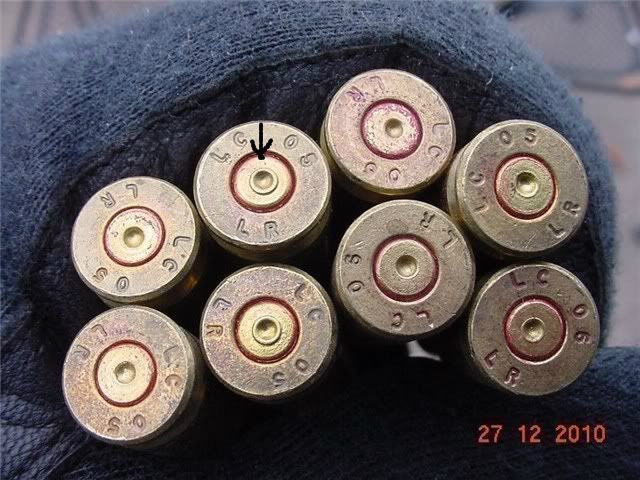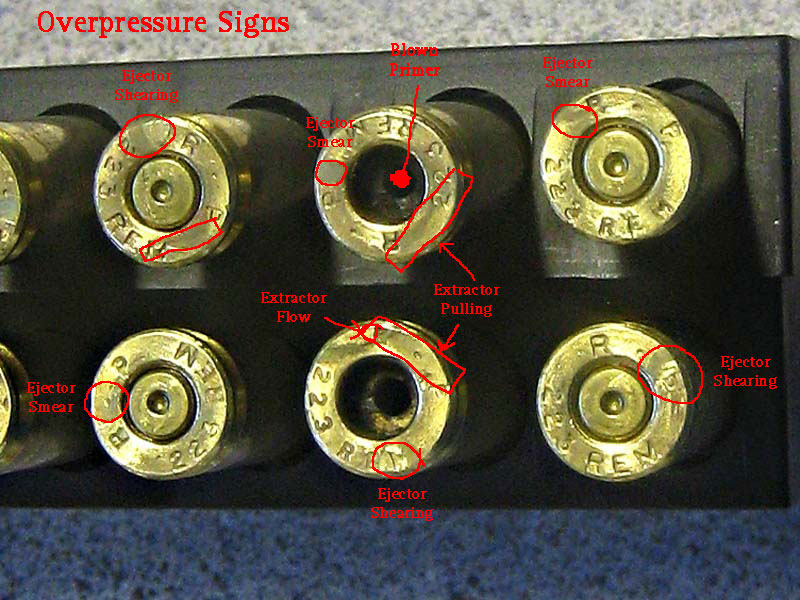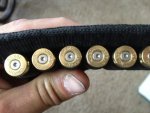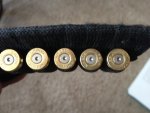hey guys whats ur thoughts on the fed 210 primers? I know they have one of the softer cups out of most primers, and my concern with them is that i may be getting false pressure readings from them. Correct me if I'm wrong, but as the primers get flatter approaching max pressure they will flatten to the point of getting ejector marks? If i switched to a harder cupped primer (cci) would i see less flattening and possibly be able to increase the load? I am also aware of cratering and looking for that as well... On the flip side i really like the 210 primers have never had a malfunction primer related and they seat nice and tight compared to the winchester primers I've tried. FYI i use both the fed 210 and 215 for reloading my two rifles: 308 winchester and 300 winmag thanks for any input 
- Thread starter AIdog
- Start date
You are using an out of date browser. It may not display this or other websites correctly.
You should upgrade or use an alternative browser.
You should upgrade or use an alternative browser.
hey guys whats ur thoughts on the fed 210 primers? I know they have one of the softer cups out of most primers, and my concern with them is that i may be getting false pressure readings from them. Correct me if I'm wrong, but as the primers get flatter approaching max pressure they will flatten to the point of getting ejector marks? If i switched to a harder cupped primer (cci) would i see less flattening and possibly be able to increase the load? I am also aware of cratering and looking for that as well... On the flip side i really like the 210 primers have never had a malfunction primer related and they seat nice and tight compared to the winchester primers I've tried. FYI i use both the fed 210 and 215 for reloading my two rifles: 308 winchester and 300 winmag thanks for any input
Flattened primers are only one sign of pressure. Are you seeing any other pressure signs like primer cratering, ejector marks, or hard bolt lift? For what it's worth, I have loaded the same load with both CCI and Federal large rifle primers and didn't notice a whole lot of difference between them.
i definitely look for other signs of pressure like all that u have mentioned... i have never spiked a load to the point of getting a heavy bolt lift because in my experience i always stop at the sign of ejector marks and/or cratering. but will different primers give different readings of pressure?
but will different primers give different readings of pressure?
Quite possibly, yes.
anyone else? any experience with this?
I wouldn't worry about Federal 210s being "too soft". Whatever clues you get from examining your fired primers are just a snapshot. Every load will have limits and I don't see a connection between Federal or any other primer. You may have to adjust propellant charge, (slightly) because of intensity of ignition but you have to adjust loads based on every component change. That's just the way it is.
For what it's worth, I use Federal 210M primers in every rifle I own, except one, and including 5 different Ackley's operating at rather high pressures. The "too soft" comment is just not a valid concern, I trust Federal large rifle primers and they get no flatter than any brand, and I have used everything on the market, at one time or the other, so it's not a case where Federal is ALL I am familiar with.
Depending on your bullet, I think you could just as soon use the 210 on your 300, although that's the one rifle where I use a standard Win 8 1/2 LR primer just because. Large rifle primers seem to work very well in 300WM, except for very heavy charges of spherical powders in cold weather.
Short answer, use the fed 210 with confidence, it's a great primer. A caution. Do not work up a load, and suddenly switch primers. The proper method is; start with a primer, don't switch the primer after you have reached your suitable accuracies and operating pressures. BB
For what it's worth, I use Federal 210M primers in every rifle I own, except one, and including 5 different Ackley's operating at rather high pressures. The "too soft" comment is just not a valid concern, I trust Federal large rifle primers and they get no flatter than any brand, and I have used everything on the market, at one time or the other, so it's not a case where Federal is ALL I am familiar with.
Depending on your bullet, I think you could just as soon use the 210 on your 300, although that's the one rifle where I use a standard Win 8 1/2 LR primer just because. Large rifle primers seem to work very well in 300WM, except for very heavy charges of spherical powders in cold weather.
Short answer, use the fed 210 with confidence, it's a great primer. A caution. Do not work up a load, and suddenly switch primers. The proper method is; start with a primer, don't switch the primer after you have reached your suitable accuracies and operating pressures. BB
good to know thanks... the only primers I've loaded with has been the fed's and a few people have mentioned that they were "too soft" but i will just disregard there comment because they have worked very well for me. but without ever have using other brands u just don't really know, thanks for ur input. ill try the 210's in the winmag too so far I've only used the 215's (using reloader 22 powder) (208 amax).
Correct me if I'm wrong, but as the primers get flatter approaching max pressure they will flatten to the point of getting ejector marks?
If your getting ejector marks on your primer, you got bigger issues. The two things I look for in primers is "flattening" and "cratering." The later being fairly unreliable as its dependent on firing pin to bore fit.



Ejector marks come from a high pressure load where the brass case head "flows" into the ejector cavity. When the bolt is turned it shaves off this protrusion leaving a shiny surface and increased effort to turn the bolt. This is, absent any over annealing issues, proof positive that you have exceeded the pressure limits of your configuration.

I do find that Federal FGMM SR/LR Primers to show flattening earlier in the pressure curve then other primers. They do have a tendency to give false results of high pressure. This is why its important to understand ALL of the signs for both semi-bolt-single shot guns. Another clue is a chronograph
Last edited:


these were my testers using varget starting at 41gn ending at 44gn stepped .5gn... wanting to settle around 43.5-44gn because the velocity is acceptable for a 20" barrel. 44gn=2525fps would like to get as close the 2600fps as possible but pressures do limit what u can achieve.
not exactly confident of the crony f1's readings but it showed a 40.0gn charge=2291fps sounds really slow to me at first i didn't believe it. keep in mind this is a factory 1in10 twist remington 308 20" barrel.
the starting charge of 40.0 gn (2291)showed no cratering, or flat primer, but with a little ejector swipe (all low pressure charges have shown ejector swipes in this rifle)
41.0gn (2355) the first sign of cratering shows although the primer is very round
42.0gn (2395) cratering is noticeable but not severe, ejector swipe is seen, primer is getting flat (not completely flat)
44.0gn (2526) cratering is visible but has not worsened, no visible ejector swipes at all (42.5,43.0,43.5,44.0), primer still has a little roundness but for the most part is perceived as flat...
wanting to settle near 44.0 gn
Chasing speed is great if it shoots at that speed. Truth is the difference at in elevation and wind from 2525 to 2600 is nothing.
I use OCW to work up a load, there are many ways to do this but it works for me.
OCW Overview - Dan Newberry's OCW Load Development System
Find a load that shoots, check its speed to get basic come ups, verify that in the field and adjust.
FWIW, my OCW for Varget/175's was 43.3 and 45.0, with Hornady Brass. The 45.0 load worked well with Winchester, Lupua is a bit thinker then both.
I use OCW to work up a load, there are many ways to do this but it works for me.
OCW Overview - Dan Newberry's OCW Load Development System
Find a load that shoots, check its speed to get basic come ups, verify that in the field and adjust.
FWIW, my OCW for Varget/175's was 43.3 and 45.0, with Hornady Brass. The 45.0 load worked well with Winchester, Lupua is a bit thinker then both.
Similar threads
Reloading Equipment Colorado fed 210 primers trade for fed 215 magnum
- Replies
- 11
- Views
- 392
- Replies
- 0
- Views
- 224
- Replies
- 27
- Views
- 1K
- Replies
- 22
- Views
- 2K
